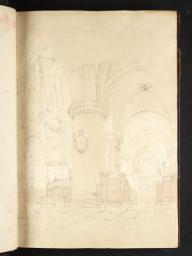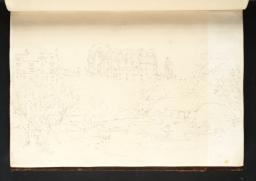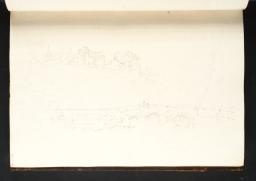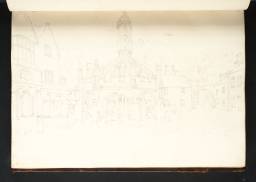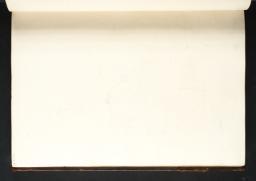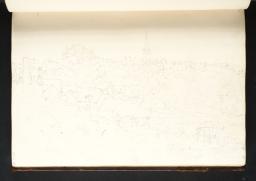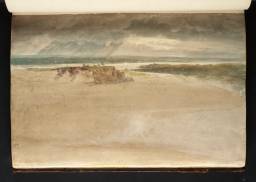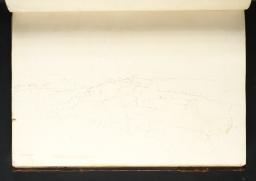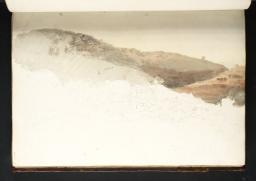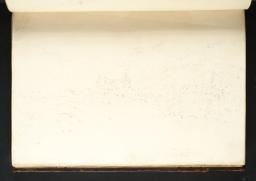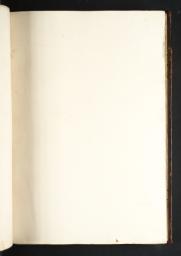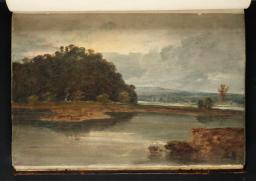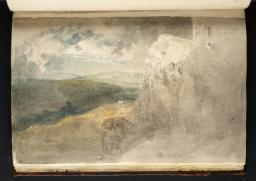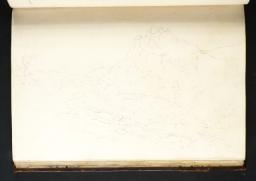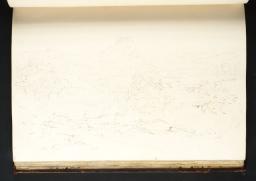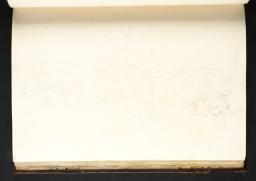Turner Bequest XXXVIII 1–101
Sketchbook bound in boards covered in brown calf leather with four brass clasps (broken)
107 leaves of and paste-downs of white wove paper; various leaves watermarked ‘1794 | J Whatman’; page size 332 x 229 mm
Inscribed by Turner ?in ink ‘South Wales | and | North Wales’ on front cover, ascending vertically (the second line only now legible)
Inscribed in ink ‘XXXVIII’ on paper label on front cover, top right
Numbered 153 as part of the Turner Schedule in 1854 and endorsed by the Executors of the Turner Bequest inside front cover (see main catalogue entry)
Inscribed by Arthur Magyer Hind in pencil ‘Restored & rebound as near as possible to | the original order, 1934 AMH’ inside front cover (see main catalogue entry)
107 leaves of and paste-downs of white wove paper; various leaves watermarked ‘1794 | J Whatman’; page size 332 x 229 mm
Inscribed by Turner ?in ink ‘South Wales | and | North Wales’ on front cover, ascending vertically (the second line only now legible)
Inscribed in ink ‘XXXVIII’ on paper label on front cover, top right
Numbered 153 as part of the Turner Schedule in 1854 and endorsed by the Executors of the Turner Bequest inside front cover (see main catalogue entry)
Inscribed by Arthur Magyer Hind in pencil ‘Restored & rebound as near as possible to | the original order, 1934 AMH’ inside front cover (see main catalogue entry)
Exhibition history
References
Following the North of England and Tweed and Lakes sketchbooks (Tate; Turner Bequest XXXIV, XXXV), used during Turner’s important tour of 1797, this is perhaps the most substantial book to have emerged from his tours of the 1790s. Like those two it covers a long itinerary and is full of careful pencil drawings. It also boasts an unusual proportion of richly coloured sheets, testifying to the artist’s increasing willingness to use watercolour while travelling.
This trend was to reach a spectacular culmination in 1799 when he took large sheets of paper with him to Snowdonia and realised a long series of studies on the mountains in colour on the spot (see the sub-section of this catalogue comprising separate sheets relating to the Welsh tour of that year) – a feat never repeated during his career, though he was to make some large drawings, a few of them coloured, in France and Switzerland in 1802. The mountains of Snowdonia were the first of any size that he had encountered – considerably higher and grander than the hills of the Lake District – and he was determined to use this experience of Sublime scenery to expand his technical range.
As Finberg points out,1 the experimental nature of the book relates it to the Wilson sketchbook of a year or so earlier (Tate; Turner Bequest XXXVII), and the influence of Richard Wilson (1713–1782) is strong in a sequence of drawings recording a tour across the length of Wilson’s native Wales. Turner was to recall many years later, in 1847, ‘the days of my youth when I was in search of Richard Wilson’s birthplace,’2 and this (together with the 1799 tour) is probably the trip he had in mind.
The sketchbook is one of five that Turner took with him on this tour. The others are: North Wales (Tate; Turner Bequest XXXIX), Dynevor Castle (Tate; Turner Bequest XL), Cyfarthfa (Tate; Turner Bequest XLI), and Swans (Tate; Turner Bequest XLII; included in a subsequent section of this catalogue owing to its coverage of other material). To some extent, he used the books in alternation throughout his tour, so that, for example, subjects in the Hereford Court book recur in the North Wales book, which, being smaller in format, was perhaps more conducive to rapid note-taking. He began his tour in Bristol, staying with his old family friends the Narraways (see the Bristol and Malmesbury sketchbook, Tate; Turner Bequest VI). Ann Dart, a niece of Mr Narraway, later recalled that ‘Turner went from my uncle’s house on a sketching tour in North Wales. My uncle gave him a pony, and lent him a saddle, bridle and cloak, but these he never returned.’3
Turner’s precise itinerary is hard to reconstruct since the sketchbook was disbound and the original order of its pages lost (see the Technical notes below), making identification of many of the subjects difficult or impossible. However, the broad outlines are clear enough. He crossed the Severn and proceeded up the Wye, through Chepstow, past Tintern, and over to Brecon; then to Cardiff and Ewenny, which he had visited in 1795. His visit to the ironworks at Cyfarthfa was presumably prompted by a request from Anthony Bacon for four views of Richard Crawshay’s famous works; see folio 107 verso (D01249). Moving out of Glamorgan, Turner joined the valley of the Tywi (or Towy) and followed the river to the coast at Llanstephan, cutting across to Pembroke and Cilgarren.
From there he set off north to Aberystwyth and Dolgellau, and made many drawings of Cader Idris from different viewpoints, making a detour to the east towards Dinas Mawddwy. He followed the Mawddach estuary to Barmouth, passed Harlech and the estuary of Traeth Mawr, then entered Snowdonia through the pass of Aberglaslyn and after exploring the mountains thoroughly he returned via Denbigh, Llangollen and Ludlow. He stopped at Hampton Court in Herefordshire, a seat of the fifth Earl of Essex (1757–1839), to make drawings for Sir Richard Colt Hoare (1758–1838), whose commission for views of that house, together with another for some views at Malmesbury, may, together with Anthony Bacon’s order for views of Cyfarthfa, have prompted the tour.
Turner had already made drawings of Hampton Court for the Earl of Essex (Viscount Malden until 1799) when he passed through Herefordshire in 1795. Gerald Wilkinson4 says that some drawings in the Hampton Court book were done in that year, but this seems unlikely, partly on stylistic grounds, partly because it would have been odd for Turner to have carried with him so substantial a book and not to have put it to better use than to make the two fairly slight pencil drawings of the house, folios 101 recto and 102 recto (D01320, D01321; Turner Bequest XXXVIII 66, 67). Another possible explanation for his interest in Hampton Court at this juncture is that he was stimulated by his work with the architect James Wyatt (1746–1813) at Fonthill to record other of Wyatt’s projects, which would perhaps explain the note of a detail of the modern alterations at Hampton Court in the Dynevor Castle sketchbook (Tate D01595; Turner Bequest XL 78a). Wyatt’s involvement at Hampton Court is not confirmed, but this fact might strengthen the case for it.5
Commissions aside, the choice of Wales, and specifically the mountains of North Wales, as a destination followed naturally from the previous year’s journey to the Lake District. It was to be followed by the second tour to Snowdonia, mentioned above, in 1799, and by a visit to the Highlands of Scotland in 1801 (see subsequent sections of this catalogue). The Hereford Court book was an important source of material for the watercolours and paintings that Turner produced, and exhibited, in the last years of the decade, and he continued to refer to it in later life, principally when selecting subjects for the watercolours engraved for the Picturesque Views in England and Wales in the 1820s and 1830s.
Inside the front cover, Turner has written in pencil ‘Mr Morris Newbury’ at the top left, ascending vertically; there are also some paint smears. One of Turner’s most important commissions for work based on material gathered on this tour was from Anthony Bacon, who, according to Turner’s note on folio 107 verso (D01249), lived ‘near Newbury’. Mr Morris may have been a connection of Bacon. Inside the back cover there are red and blue paints trials. The gilt tooled spine, according to Finberg, formerly bore a parchment label inscribed ‘94 Lakes Hereford Court. Lakes. Malmesbury’.6
The front paste-down also bears the 1854 schedule number and endorsement of the executors of the Turner Bequest, George Jones, John Prescott Knight and Charles Lock Eastlake in ink ‘No 153. | George Jones’ and in pencil ‘JPK’ and ‘C.L.E.’ at the top left. Above the centre, National Gallery curator R.N. Wornum has commented in pencil ‘Four out | R.N.W. 1868’. Towards the top right, British Museum curator Arthur Magyer Hind has noted in pencil ‘Restored & rebound as near as possible to | the original order, 1934 AMH’ (see the Technical notes below) and begun another inscription, limited to ‘Note that’, to the left of the centre.
John Gage, (ed.), Collected Correspondence of J.M.W. Turner with an Early Diary and a Memoir by George Jones, Oxford 1980, p.219 letter 307.
A recent and comprehensive account of the architect’s life and work, John Martin Robinson, James Wyatt, Architect to George III, New Haven and London 2012, makes no mention of Hampton Court. For Turner’s relations with Wyatt, see Andrew Wilton, ‘Post tenebras lux: J.M.W. Turner, James Wyatt and the importance of stained glass’, Burlington Magazine, vol.154, May 2012, pp.322–9.
Technical notes
How to cite
Andrew Wilton, ‘Hereford Court Sketchbook 1798’, sketchbook, May 2013, revised by Matthew Imms, January 2015, in David Blayney Brown (ed.), J.M.W. Turner: Sketchbooks, Drawings and Watercolours, Tate Research Publication, April 2015, https://www



